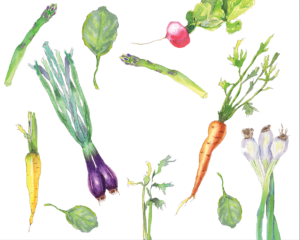 The return of spring brings with it the return of a host of delicious vegetables to the farmer’s market. This guide provides an overview of some of our favorite spring vegetables.
The return of spring brings with it the return of a host of delicious vegetables to the farmer’s market. This guide provides an overview of some of our favorite spring vegetables.
 Artichokes
Artichokes
Don’t let their spiky exterior deter you! Globe artichokes are a tender vegetable with a delicate, nutty flavor.1 They are a great source of dietary fiber, as well as vitamin C, vitamin K, folate, potassium, and magnesium.1–3 Pick artichokes with tight, thick leaves that squeak when you rub them together.2,4 Make sure to clean with cold water and remove the spikes before cooking.2 Once it’s prepared, feel free to steam, boil, grill, or stuff—the possibilities are as plentiful as the nutrients!
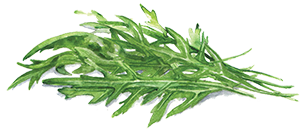 Arugula
Arugula
This little leaf packs a peppery punch, adding depth to any salad. Vitamin K is its most abundant nutrient, providing about 28 percent of the daily value in one cup.5 It also contains vitamin C, calcium, folate, vitamin A, and iron.5,6 When selecting arugula, avoid wilted, yellow- or brown-colored, or damp leaves.4 Add raw arugula to sandwiches, add it as a pizza topping, or eat it sautéed in pasta or as a side dish.
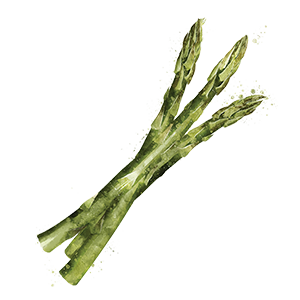 Asparagus
Asparagus
Local asparagus is a real spring treat, with high amounts of vitamin K and folate, and smaller amounts of vitamin C, vitamin A, and iron. Furthermore, asparagus is a good source of antioxidants.7,8 Look for bright green spears with tight, slightly purple heads for ultimate freshness. Avoid spears with pale ends, as they are tough and fibrous.4 Although it’s more common to see sautéed, baked, or boiled asparagus, you can eat them raw as well.
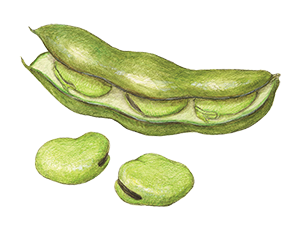 Fava Beans
Fava Beans
Fava beans, or broad beans, are large, light-green colored beans with a mild, slightly sweet flavor. Fava beans are encased in pods and surrounded by a tough skin, thus requiring a double-shelling process; however, young, small pods can be eaten whole.9,10 Like other beans, fava beans are an excellent source of protein.11,12 They are also rich in folate, manganese, copper, and phosphorous,11 in addition to providing moderate amounts of thiamine, iron, riboflavin, and potassium.11,12 Select pods that are bright, plump, and firm, with no brown spots.4,10
 Peas
Peas
Peas have a sweet flavor, with plenty of varieties to try. Sugar snap and snow peas are typically eaten in the pod, whereas green peas, or English peas, have inedible pods and must be shelled.13,14 Despite their different appearances, sugar snap and snow peas have identical nutrition profiles. They are particularly high in vitamin C, and they also contain good amounts of fiber, vitamin K, vitamin A, folate, and manganese.15,16 Compared to their edible podded counterparts, green peas contain more protein and carbohydrates.13,15,16 Green peas are also a good source of fiber, vitamin A, vitamin K, thiamin, manganese, and iron.13,17 Choose bright green-colored pods without brown, dry, withered areas.4
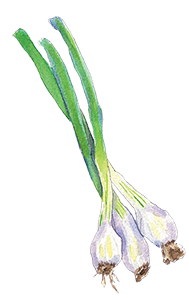 Scallions
Scallions
If you want to add a mild oniony flavor to your dishes, look no further than scallions. Also known as green onions, these plants are harvested before the onion bulb fully forms, hence their mild flavor.18,19 Both the white bulb and greens are edible, with the green having an even milder, fresher flavor.18 Scallions are a good source of vitamin A, vitamin C, and folate.19,20 The scallion’s most prominent nutrient is vitamin K—one medium scallion has 34 percent of the daily value of vitamin K for women.20 Choose scallions with a firm bulb and long, bright green-colored stems; avoid scallions that feel slimy or have wilted or brown stems.19 Scallions are versatile; you can serve them as a side dish, use them as a garnish, or incorporate them into virtually any recipe.
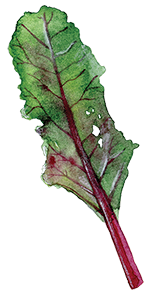 Swiss Chard
Swiss Chard
Swiss chard adds a welcoming pop of color after the muted winter months. It has a mild and sweet earthy taste, with a note of bitterness that is lost when it’s cooked.21 Like other leafy greens, Swiss chard is full of nutrients, providing vitamin K, vitamin A, vitamin C, copper, iron, manganese, magnesium, vitamin E, potassium, and calcium.21,22 Look for thick stems with dark green leaves absent of yellowing.4 Both the stem and leaves can be eaten, making them an easy, nutritious addition to any meal.
Sources
- Editors of Encyclopedia Britannica. Artichoke. Encyclopedia Britannica. Updated 14 Mar 2023. https://www.britannica.com/plant/artichoke. Accessed 17 Mar 2023.
- Zolotareva A. In season now: artichoke. Foodsmart. https://www.foodsmart.com/blog/season-now-artichokes. Accessed 17 Mar 2023.
- California Artichoke Advisory Board. Health and nutrition. http://artichokes.org/recipes-and-such/health-and-nutrition. Accessed 17 Mar 2023.
- Chappell MM. In-season produce: your guide to spring vegetables and fruits. Forks Over Knives. Updated 16 Mar 2023. https://www.forksoverknives.com/how-tos/spring-season-vegetables-fruits-guide/. Accessed 17 Mar 2023.
- Ware M. Everything you need to know about arugula. MedicalNewsToday. 16 Jan 2020. https://www.medicalnewstoday.com/articles/282769. Accessed 17 Mar 2023.
- LettuceInfo.org. Arugula FAQ. https://lettuceinfo.org/arugula-faq/. Accessed 17 Mar 2023.
- Coyle D. 7 reasons why you should eat more asparagus. Healthline. 4 Apr 2018. https://www.healthline.com/nutrition/asparagus-benefits. Accessed 17 Mar 2023.
- Zolotareva A. In season now: asparagus. Foodsmart. https://www.foodsmart.com/blog/season-now-asparagus. Accessed 17 Mar 2023.
- Alfaro D. What are fava beans? The Spruce Eats. Updated 29 Dec 2022. https://www.thespruceeats.com/what-are-fava-beans-995664. Accessed 17 Mar 2023.
- FoodPrint. Real food encyclopedia: fava beans. https://foodprint.org/real-food/fava-beans/. Accessed 17 Mar 2023.
- Streit L. 10 impressive health benefits of fava beans. Healthline. Updated 6 Dec 2018. https://www.healthline.com/nutrition/fava-beans. Accessed 17 Mar 2023.
- Editors of Encyclopedia Britannica. Broad bean. Encyclopedia Britannica. Updated 23 Feb 2023. https://www.britannica.com/plant/broad-bean. Accessed 17 Mar 2023.
- Broihier K. Fresh peas mean spring’s delicious arrival. Food and Nutrition. 26 Feb 2016. https://foodandnutrition.org/march-april-2016/fresh-peas-mean-springs-delicious-arrival/. Accessed 17 Mar 2023.
- Kennedy R. All about edible pod peas. 23 Mar 2022. Gardener’s Path. https://gardenerspath.com/plants/vegetables/edible-pod-peas/. Accessed 17 Mar 2023.
- Due C. What’s the difference between green peas, snow peas, and sugar snap peas? University of Arkansas Division of Agriculture Research and Extension. https://www.uaex.uada.edu/counties/miller/news/fcs/fruits-veggies/Whats-the-Difference-Between-Green-Peas-Snow-Peas-and-Sugar-Snap-Peas.aspx. Accessed 17 Mar 2023.
- Berkheiser K. What’s the difference between snow peas and sugar snap peas? Healthline. 7 Dec 2018. https://www.healthline.com/nutrition/snow-peas-vs-sugar-snap-peas. Accessed 17 Mar 2023.
- Elliot B. Why green peas are healthy and nutritious. Healthline. 24 Feb 2017. https://www.healthline.com/nutrition/green-peas-are-healthy. Accessed 17 Mar 2023.
- Food Network Kitchen. What are scallions? Food Network. 22 Apr 2022. https://www.foodnetwork.com/how-to/packages/food-network-essentials/what-are-scallions. Accessed 17 Mar 2023.
- Zolotareva A. In season now: scallions. Foodsmart. https://www.foodsmart.com/blog/season-now-scallions. Accessed 17 Mar 2023.
- Dolson L. Green onion nutrition facts and health benefits. Verywell Fit. Updated 15 Oct 2020. https://www.verywellfit.com/green-onions-and-scallions-calories-and-carbs-2241792. Accessed 17 Mar 2023.
- Westenhiser T. Swiss chard. Food Source Information. Updated 2022. https://fsi.colostate.edu/swiss-chard/. Accessed 17 Mar 2023.
- Kubala J. Swiss chard: nutrition, benefits, and how to cook it. Healthline. Updated 29 Mar 2022.https://www.healthline.com/nutrition/swiss-chard#health-benefits. Accessed 17 Mar 2023.





